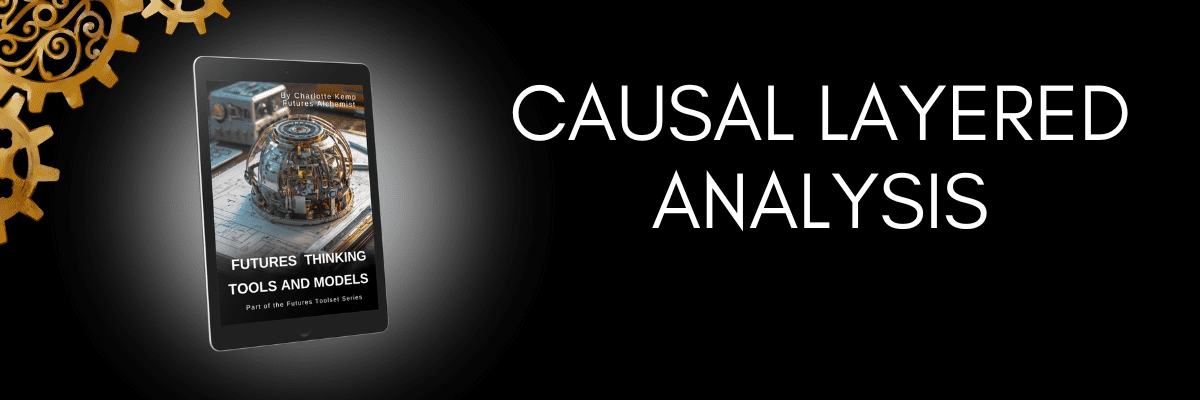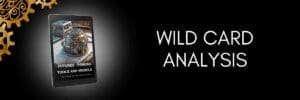
Introduction
Causal Layered Analysis (CLA) is an incredibly helpful model to dig into the deeper reasons or causes of whatever we are investigating. Essentially we are analysing the cause of the results we see at a certain layer of investigation.
CLA was designed by Sohail Inayatulla, an academic futurist who apparently uses this model before any other work is done in an organisation because it reveals so many triggers that are otherwise hidden and unconsidered. His work is highly cited and this is one of my favourite futures models.
Example
Let’s use a typical example to explain the model. A company has poor sales results. A typical response is to motivate, or threaten, the sales team, consider the sales targets, offer incentives. All the focus is on the sales figures, and not what is causing those sales figures to be what they are. The cause of the sales figures relies on the system that they are generated from. Perhaps the system is outdated or flawed. You can’t change the results of the reported figures unless you change the system. We can then fiddle around at that level for a long time and still not see real change, because we may need to consider the worldview that this system is based on. And that worldview is born from the myths and metaphors of the community.
This may seem like a great deal of work just to get sales people to reach targets, but it can be more fundamental than that. Any real change, any real preparation for the future is going to require some deep work. And once the work is done, the changes make themselves and we begin to move with the flow of the future, instead of trying to fight it.
What it looks like
Litany / Data
Imagine a typical iceberg with only one quarter of the structure visible above the waterline. Below the waterline 3/4 of the iceberg exists. The very top level that is visible, refers to the litany, or the data that we have about a situation. It is the information that is available to everyone and is reported in the media, company documents, or journals. It is what we see and say about a situation.
It is this level that is most often addressed when a problem is identified in a company. In our example, when sales are down so bosses talk louder to incentivise or threaten sales staff to get more sales.
Systems
However those sales figures, or any data that we are measuring, are a product of the systems that are in place in an organisation. The systems drive the surface litany. For our sales example that could mean that a company has an attractive incentive plan and the plan rewards good sales people so that they will make more sales because they feel recognised. Consequently the visible/data level figures look better. The system could also be along the lines of the Glengarry Glenn Ross movie: the worst sales performers will be fired. That system results in actions that are measured by the figures in the litany/data level. The systems could also consider the relevance of the product for the local market, competition of this product versus alternatives that are available and how relevant this product is in a changing world.
Worldview
Beneath that level, beneath the systems, is the worldview of the organisation. This is where we discover why we think the way that we do. These worldviews could include capitalism, socialism, a religious world view, a nationalist or protectionist worldview. These could also be a scarcity or zero sum world view or an abundant, cooperative worldview.
Myth / Metaphor
And the last layer that we explore is the myth/metaphor layer. These are the stories that define our identity. Think how many times you have heard expressions such as it takes a village to raise a child (collectivist worldview), the invisible hand runs the market (capitalist worldview), the rising tide lifts all boats (an abundance world view) humanity is the architect of the future and technology will solve our problems (technocratic or progress oriented world view).
To continue our simple example in terms of sales, this myth/metaphor level could be described as ‘time is money’, the so-called ‘American Dream’ where anyone who works hard can succeed. This translates into the capitalist world view.
The individualist world view is seen in the example of ‘pull yourself up by your bootstraps’ and the myth of the self-made man.
The layers together
Each upper layer is dependent on what is believed in the layer beneath it. In a society based on the metaphor of life is a battlefield and ‘if I don’t take it someone else will’ the world view is defined by scarcity and the zero sum game. That will create the systems for an organisation to run where those people with the means will extract as much value or opportunity for themselves as possible and not care who is left behind in the process. These systems are reflected in the economy of the country, the laws and taxation of that country, and the foreign policy of that country. The very top litany / data layer will be measured in the value of wealth, profit, market share and political influence.
A more interconnected, systems, ecology world view will recognise the value of all individuals and the environment and not measure success by extracted value but by added value.
Why it works
Without understanding the layers below, most organisations simply attempt to address the top, visible layer. They work harder, hustle, and pressurise people to change the results.
Without judgement, this model offers the framework to understand a situation at a deeper level. We work our way down the levels, discovering what is hidden, uncovering stories we tell ourselves that unknowingly determine how we operate.
Inevitable, effortless results
Once we get to the bottom later and hear those myths we share that explain the world for us, once we get over the huge discomfort that some of those stories bring, then we get to do the fun part of this exercise. We get to intentionally craft new narratives. We can choose the metaphors we live our lives by. If we don’t like the military metaphor of strength, dominance and offensive actions, then we might replace it with an ecosystem metaphor. If ‘father knows best’ metaphors of patriarchy don’t serve us, then we can choose a more nurturing metaphor. Once we define the stories that we are going to tell, then our worldview evolves from that. Instead of unthinkingly accepting an unexamined worldview, we can choose how to define our beliefs, religion, relationships, hierarchies etc. And from that foundation we then develop systems to live by. Instead of carrot-or-stick systems, perhaps we have a system that acknowledges and recognises creative endeavours. And from there the results, the litany level, flow naturally. There is no need to force results because they are an inevitable result of the system that produces them. If you have the right system, you will have the desired results.
Personal application
While we talk about this model in terms of business and organisations, it can also be used personally. If you are not happy with your health, then check your systems, work through your worldview and discover what stories you tell yourself about how you are always sick and everyone in your family has high cholesterol. Not happy in your relationships? What do you tell yourself about the type of person you deserve in your life? Your personal finances? Management of your mental health? Achievement of your goals and dreams? Travel?
Explaining other situations
This model is also very useful to unpack what is happening elsewhere to understand it better. So instead of applying it to your own business or circumstance, you can use it to try to fathom something else. The rise of conservative, right wing politics reveals a worldview of religious and racial beliefs that come from a myth of the superiority of white, Christian, men.
You can also use this model to determine where I personally stand on some of these issues.
A word of warning
Keep Uncle Ben’s warning in mind: with great power, comes great responsibility.
When we use a model like this to reveal a worldview and bring those myths out into the light, it is going to have an effect. We would want that effect to be that someone rationally re-examines their beliefs and is prepared to make a change where necessary. But many people are not prepared for that.
It is not ethically appropriate to systematically undermine a person’s foundational beliefs without offering some support for them to re-establish them. This model has the power to redirect people and organisations. It also has the power to destroy blind faith and leave a person reeling psychologically. Don’t use it as a weapon but as a way to intentionally create our shared, preferred futures.




